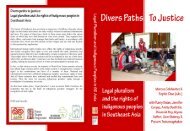The Upper Caura, Venezuela - Forest Peoples Programme
The Upper Caura, Venezuela - Forest Peoples Programme
The Upper Caura, Venezuela - Forest Peoples Programme
You also want an ePaper? Increase the reach of your titles
YUMPU automatically turns print PDFs into web optimized ePapers that Google loves.
Protecting and encouraging customary use of biological resources: <strong>The</strong> <strong>Upper</strong> <strong>Caura</strong>, <strong>Venezuela</strong>_________________________________________________________________________________________6 State Interventions and Legal StatusState penetration of the region was very slight until the 1960s and remains tenuous eventoday. <strong>The</strong> only permanent presence of government agencies in the <strong>Upper</strong> <strong>Caura</strong> consists oftwo hydrology stations at Entre Rios and Guaña, currently manned by Ye’kwana employees,small dispensaries in most of the larger settlements run by Ye’kwana and Sanema paramedics,and primary schools which are also staffed by indigenous teachers. Catholicorganisations established mission stations among the Ye’kwana in the <strong>Upper</strong> <strong>Caura</strong> from1955. <strong>The</strong> first established at Kanadakuni was later abandoned but the mission at Sta.Maria maintained by Les Petits Frères Foucauld remains. Evangelical missions have alsobeen established among the Sanema at Shimadaiña and Majaguaña and among theYe’kwana at Chajuraña, most of which are served part time by non-indigenous pastors. <strong>The</strong>Catholic missions, Les Petits Frères Foucauld and Fé y Alegría, have also provided someassistance to establish simple schools among the Sanema of Ayawaiña, Yudiña andMinchöña where there is an absence of suitably qualified Sanema teachers who can gainState recognition and support.Medical services to the region are slight and the low population density is substantially dueto the fact that the whole region experienced massive epidemics in the 18 th , 19 th and 20 thcenturies. Tuberculosis and malaria remain major problems in the territory, especiallyamong the more isolated and mobile Sanema communities of the <strong>Upper</strong> Erebato andMerevari. 24 During the 1970s, the Ministry of Health established a medicina simplificadaprogramme, which led to the training of young Ye’kwana men with primary schooleducation in simple diagnosis and nursing skills. Small clinics and dispensaries were alsoestablished and intermittently supplied with drugs and other medical supplies. A similarsystem of rural dispensaries manned by enfermeros (nurses) remains in place to day, but isnow supplemented by a mobile health brigade mainly made up young doctors carrying outtheir probationary year of practise in rural areas after qualification, who visit the mainriverine communities of the region once every three months to carry out immunisationsand hold one-day clinics. <strong>The</strong> programme does not reach many of the more isolatedSanema villages and has had limited success in curbing the main killers – malaria andtuberculosis – or the major chronic, endemic diseases such as leishmaniasis andonchocercosis. <strong>The</strong> health situation of the Sanema in the <strong>Upper</strong> <strong>Caura</strong> remains a seriousissue of concern.Frontier DevelopmentSince the early 1970s, elements in government have promoted a forward policy of frontierdevelopment in southern <strong>Venezuela</strong>, centred around colonisation schemes, industrialdevelopment and road-building. <strong>The</strong>se efforts have focused mainly on Amazonas State(where they have been markedly unsuccessful) and other parts of Bolivar State, where theyhave resulted in several large-scale mining, smelting, hydropower and road-buildingschemes all of doubtful economic viability. To date the <strong>Caura</strong> has not been affected by thesepharaonic dreams although past maps have shown a proposed road linking Sta Elena deUairen in the east of Estado Bolivar with San Juan de Manapiare in Estado Amazonas,which would have run right across the <strong>Upper</strong> River, as part of military plan to increasefrontier security. However, commencing in 1976, the government carried out detailed24 For a detailed but dated review of the health situation and disease ecology see Marcus Colchester, 1985,<strong>The</strong> Health and Survival of the <strong>Venezuela</strong>n Yanoama. Document 53 of the Anthropology Resource Center,Survival International and International Work Group for Indigenous Affairs, Copenhagen.29
















